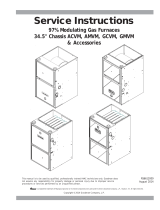
Page 2
506080-02 5/2017
Requirements
IMPORTANT
Read all of the information in this manual before using
this thermostat.
All wiring must conform to local and national building
and electrical codes and ordinances.
This is a 24VAC Class II voltage thermostat. Do not
install on voltages higher than 30VAC.
Be sure that power routed to the thermostat has been pow
ered off before beginning installation.
This thermostat should be used only as described in this
manual.
Do not install the thermostat on outside walls (where there is
unconditioned space on opposite side of wall) or in locations
where direct sunlight may be present.
Install thermostat about 5 feet up from the floor.
CAUTION
Do not short (jumper) across terminals on the gas
valve or at the system control to test installation.
This will damage the thermostat and void the war
ranty.
Installation
NOTE - If this thermostat is replacing an existing thermo
stat, carefully label the existing thermostat wires so that
they can be identified later.
1. If a previously‐installed thermostat exists, remove it;
if none exists, identify the location for installation (lo
cate, or install wiring as necessary). To facilitate instal
lation, enlarge the hole where the thermostat wires
protrude through the wall to about 1-1/2” wide by 3/4”
high.
2. Pull about 3 inches of the thermostat wiring through
the wall opening. Strip 1/4” of the insulation from the
ends of the thermostat wires to be used.
3. Use a screwdriver to remove the thermostat subbase
from the body. Carefully pry the subbase away from
the body along the bottom edge of the base near the
two mounting snaps; then lift the subbase upward.
4. Use the subbase as a template to mark the desired
mounting hole locations on the wall.
5. Drill two 3/16” holes at the marked locations on the
wall. Insert the provided plastic wall anchors provided
into the holes. Press the anchors into the holes until
anchors are flush with the wall.
6. Align the subbase over the plastic anchors and secure
it to the wall using the provided screws.
7. Use a small slotted screwdriver to secure all wires to
the subbase terminal block. Make thermostat connec
tions as follows:
DL3011C - See table 1 and figure 1.
DL3021H - See table 2 and figure 2.
8. Thermostat L3021H Only
DFor most applications, E will be jumpered to W1. If
separate wires are not provided for both E and
W1, jumper the E terminal to the W1 terminal on
the thermostat subbase.
DFor dual-fuel applications (heat pump with gas fur
nace), OR for auxiliary heat lockout applications,
the optional outdoor sensor (part number X2658)
MUST be installed.
DConnect the outdoor temperature sensor wires to
the T terminals on the subbase terminal strip. (The
sensor connections are not polarity-sensitive.)
9. After wiring is complete, thoroughly seal the hole in the
wall with a suitable material to prevent unconditioned
air in the wall space from entering the thermostat.
10. Set the thermostat DIP switches as required for the
application. See table 3 for DIP switch settings.
11. Carefully attach the thermostat to the subbase by first
engaging the hinges at the top of the unit, then pivoting
the thermostat downward until the thermostat snaps
into place.
The thermostat is now ready for operation. Turn on
power to the thermostat and refer to the appropriate
thermostat operation manual: 504,865M for L3011C
or 504,931M for L3021H.
12. Remove the clear protective film from the face of the
thermostat display.
Note: After this film is removed, some dark streaks or
lines may temporarily appear on the display. These
are normal and should disappear within a few minutes.
Removing Thermostat
The thermostat hinges on tabs on the top of the subbase.
After installation is complete, no tool is needed to remove
the thermostat from the subbase. Pivot the bottom of the
thermostat outward (releasing the snaps), then lift up to re
move.
Table 1. L3011C Terminal Designations
Terminal Description
R 24VAC
GFan control
Y1 First stage cooling
W1 First stage heating
LService Indicator
C24VAC common







